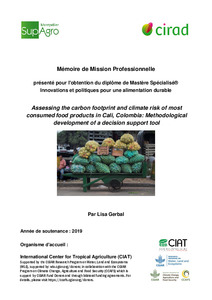Assessing the carbon footprint and climate risk of most consumed food products in Cali, Colombia: Methodological development of a decision support tool
Title : Assessing carbon footprint and climate risk of most consumed food products in Cali, Colombia: Methodological development of a decision support tool
Cities are spreading, and with it, the impacts of a growing urban population on the environment through the provisioning of food, water, and energy. Changing climate is also threatening our food systems: the kinds of foods that can be produced, and peoples’ ability to buy them. In this context, this study aims at developing a methodological approach to better assess, understand, and use information on environmental sustainability and resilience of highly consumed products in a city. The proposal is to assess carbon footprint using a Life Cycle Analysis (LCA) methodology and complement it with the Ecocrop model that can project potential changes across space and time, of crops suitability under different future scenarios. In this way, we can assess both the impacts of a community’s diet on the environment, as well as the potential impacts of climate change on that diet. The case-study of the methodological proposition is the city of Cali, department of Valle del Cauca, Colombia and focus on the five most commonly consumed food products (per day) in Cali, determined as the “caleño typical plate”. The results found that the caleño plate emits 431.5 grams of CO2eq. The meat portion (poultry) has the highest carbon footprint per kg (2.04 kg CO2eq/kg), followed by rice (1.46 kg CO2eq/kg), plantain (0.28 04 kg CO2eq/kg), potato (0.23 04 kg CO2eq/kg) and tomato (0.09 04 kg CO2eq/kg). The Ecocrop model found that climate change could open new areas of cultivation for plantain (68% of the region will be more suitable to its production), whereas potato and most of all rice will not be suitable for culture in a majority of areas (loss of 60% of the suitable areas at the national level for rice). This proposal can be an important tool for decision makers, especially for our case study in Cali, where a fair portion of the food is produced in Valle del Cauca or else in Colombia. We hope that the results of this study will demonstrate to local policy makers the challenges of food systems, what is at stake, and the key areas for intervention.

